‘Sham’ process inflates IBR value: Don’t miss this assessment of the “fuzzy math” being used to justify the Interstate Bridge Replacement project, which economist Joe Cortright said should be considered as a federal crime. (Streetsblog USA)
Life with an a cycling lover: A sweet little column that I think a lot of “avid cyclists” can relate to. (Gold Country Media)
Rebuild walking culture: It’s very likely that a major reason more Americans are being killed while walking is that so few of us are doing it. (Streetsblog USA)
Major honor: Major Taylor, the first Black American global sports star who was simultaneously revered for athletic prowess and reviled for the color of his skin, is up for a congressional gold medal, the highest civilian honor bestowed by lawmakers in the Capitol. (The Washington Post)
Bigger cars, bigger problems: “The story of car bloat—the continually expanding size of the typical American automobile—is one of carmaker profit, shifting consumer preferences, and loophole-riddled auto regulations.” (Slate)
What to do about it: We can control the car-size problem in America by looking at Paris where their mayor wants to triple what it costs to park an SUV in the city. (Guardian)
A real climate plan: How is it that Paris is able to frame major transportation and climate-related policies and projects in a way that leads to real progress instead of the incremental stuff we do here? That city’s new climate plan is so exciting. (Momentum)
A plea for political will: Important op-ed from someone who warned PBOT Commissioner Mapps’ office about a very dangerous crossing outside a school — and then was almost killed himself at the exact location he was worried about. (The Oregonian)
Freeway failure in California: A strange and wonderful thing happened at a meeting of the California Transportation Commission: A planned freeway expansion project failed to get approval because a majority of members felt it would increase VMT and not address alternatives to driving. (Streetsblog CA)
Modeling good behavior: A new Biden admin memo says federal employees should take zero emission vehicles whenever possible. (FEDWeek)
Traffic death immunity in Salem: Lawyers for a DEA officer who struck and killed a bicycle rider say the man should be immune from prosecution because he was working a drug case and a judge has agreed to move the trial to federal court over local objections. (Statesman Journal)
Thanks to everyone who sent in links this week. The Monday Roundup is a community effort, so please feel free to send us any great stories you come across.


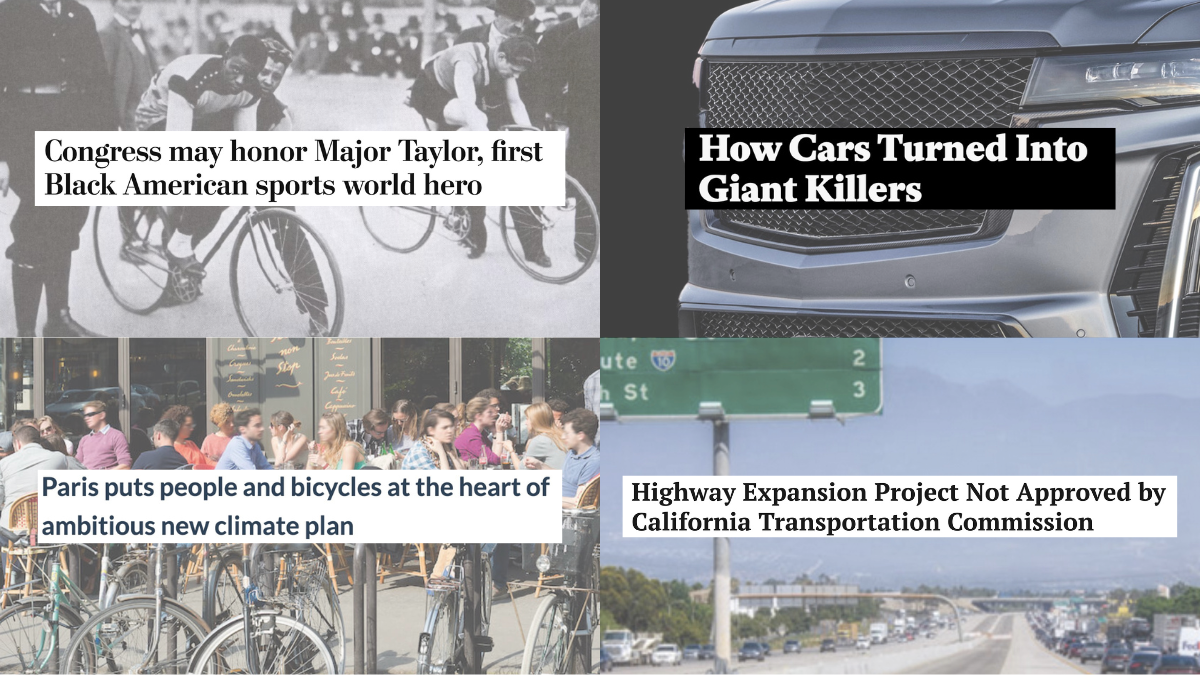
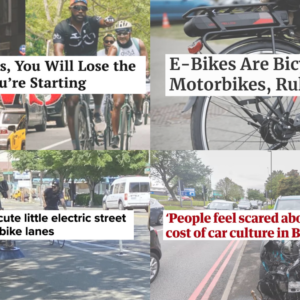
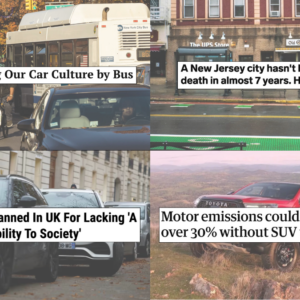
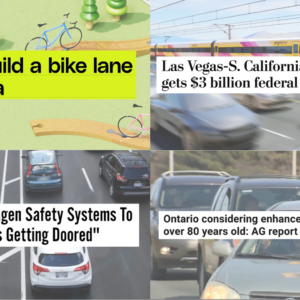
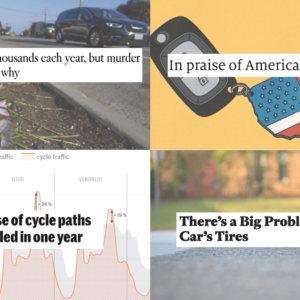
Thanks for reading.
BikePortland has served this community with independent community journalism since 2005. We rely on subscriptions from readers like you to survive. Your financial support is vital in keeping this valuable resource alive and well.
Please subscribe today to strengthen and expand our work.
Fuzzy Freeway Math: Pretty much all transportation funding decisions have absolutely nothing to do with math, as Joe Cortright knows very well – it’a all politics and perceived social benefits, be it an I-5 bridge, the sidewalk in front of your house, or a bike lane on NE 33rd – and the calculating errors he shows could just as easily be ascribed to any other project of any size, including buying your next bicycle or washing machine.
You’re right, it’s not hard to budge a calculated benefit by 100% and the Notorious ODOT is not at all serious about costs. The other stuff is different.
If I buy a washing machine it’s going to be used and it will pay off in less than a year. I operate a bike for less than the cost of a Trimet pass and can show that the benefit is greater. My ‘next bike’ is going to be a frame that I own, or pull out of the Columbia Slough, and the public is not on the hook for the parts.
The so-called IBRC consultants are playing fast and loose with about 20 years of bonding capacity. By the time this mess is paid for we’ll be even deeper in the hole of deferred maintenance. A person hooked on fentanyl doesn’t run very good numbers but they know what they want and we know what they’re probably going to do.
In purchasing your washing machine, did you evaluate, for example, the costs (in time and coins) of using a laundromat? Or borrowing the use of a machine of your neighbors or relatives? How did you evaluate convenience? Or are you so addicted to having clean shirts that you didn’t really consider any of these aspects in your decision-making?
In many ways, the example of a washing machine and your old bike frame is not all that different from the addictions of fentanyl or driving – a lot of our decision-making isn’t really rational, yet we fully expect our public agencies like ODOT and USDOT to justify spending our tax dollars in order for them to support our addictions to driving and/or receiving the newest washing machine and fentanyl delivered from Amazon or some local dealer at the most optimal price – with the costs of fuel, time, convenience, and vehicle wear-and-tear all tied in somehow.
As if all those people pool their seconds together and do any work with that time savings. It’s the same specious justification drivers use for cutting through neighborhoods. No one is using those seconds to do anything meaningful.
However if they’re going to add up all that saved time as a dollar figure then yes they should also have to add in all the lost time from tolling the bridge and making the 205 more congested. They should also have to subtract out all the lost time from the years of construction.
Finally are they really saving that time for their entire trip or do they just lose it at the next bottleneck? Maybe if you only drive those 5 miles you can claim that time savings but most people will continue on to numerous other bottlenecks in the system. Of course then they have the excuse for more expansion later on. That’s what I think is happening with the Rose Quarter. If they make it wide enough for 10 or 12 lanes and they build the bridge out with the same they can claim there’s a bottleneck in between and expand the whole corridor.
And PBOT is worried about the impacts of a bike lane on 33rd!
The Salem DEA case is absolutely ridiculous. Good to know that the DEA values maybe catching a drug dealer over an innocent persons life. And the fact that a federal agent can get a case moved to a court where they have immunity over the protests of a local jurisdiction… just nakedly corrupt.
End qualified immunity – now.
I want to point out that qualified immunity is not the same immunity that’s at issue in the DEA case.
Well… I still think we should end qualified immunity. And whatever allows the DEA agent here to weasel out of justice
Qualified immunity allows officials to not be held personally liable for violating your rights while doing their job. If it goes away, public employees will simply insure themselves against whatever liability they are exposed to, and that insurance would almost certainly be paid for by the employer.
So… what would be accomplished in the end? Even with qualified immunity, you can still sue the government if your rights are violated.
https://www.law.cornell.edu/wex/qualified_immunity
“The story of car bloat” is one that could be told about virtually any product over the past few decades: healthcare, higher ed, your computer/TV screens. You can’t tell me that adding motors has nothing to do with increasing the average sale price of bicycles, too.
Rebuilding Walking Culture: The article got me thinking about data for bicyclists and walkers, that we have so little data that is reliable compared to car driving or transit ridership, for example. The ACS is getting less reliable as fewer respondents actually fill out forms (errors are increasing) while people simply lie more on surveys these days. And then I started to think about cell phones…
Just prior to the Pandemic, our friendly local French multinational transit operator here in Greensboro NC published a series of maps using cell phone data from all local providers (Verizon, AT&T, Cricket, and so on) for a three-month period showing the 24/7 movements of all users, with aggregated data to mitigate privacy concerns. The result showed which parts of town were most popular for people to visit (job sites, shopping centers, the airport, universities, and so on) but also AM/PM peaks, general traffic flow, and roughly where people lived.
Presumably the vast majority of us are pedestrians at some time during the day, if only to get out of bed and go to the toilet, visit the fridge, and so on. We might go out bicycling, drive to work, catch MAX, etc, often (but not always) carrying our cell phone with us, with a GPS unit built in that can (and does) track our every movement. So I got to thinking that with A.I. technology, all of our individual movements cold be broken down (dis-aggregated) by speed: 0-5 mph would be walking, 8-15 mph would likely be bicycling (or using a golf cart), 15-25 mph public transit, anything over likely by car, and anything instant over a long distance would indicated that someone has invented an energizer beam (nevermind if they arrive a few seconds before they started). That data could then be re-aggregated to figure out how many distinct users are moving at walking speed (nearly everyone, but for how far and where?), bicycling (sort of), and other modes.
Or, gasp, Trimet could use the data for Portland Metro to find out where people go from point A to point B the most and see if bus lines could be tweaked to better serve customers and not force people to go to the Max lines or through downtown needlessly like they do now.
Crazy idea I know.
They did that with Forward Together. A huge amount of data about employment, density, job centers went into designing the new lines.
TriMet is still very much a hub & spoke model, and downtown is still excruciatingly slow. They still aren’t able to get their ridership back.
In other words, TriMet still doesn’t serve folks very well.
Rebuilding Walking Culture:
“It’s about transportation leaders claiming there’s ‘just no demand’ for safe walking infrastructure…”
People walking are the indicator species for safe streets. Even if Portland’s rumored Platinum was degraded to Tin Cup and bike riding was illegal, I’d still do it, just as I rode through the Rose Quarter without the bike lane and the light. Walking is different and we should all hold the line for that.
The most conspicuous failure of PBOT is the lack of safe walking routes in neighborhoods and the allowance of ANY development without safe, clearly marked public right of ways for walking.
The City of Portland has to wear the Gibbs Street debacle forever and while I’m alive it’s going to be a topic. If the Alpenrose area gets built out without sidewalks we can kiss it goodbye. They’ll excuse themselves with ‘well there’s no sidewalk over there so you don’t get one either.’
If there’s no room for a sidewalk there’s no room for a condo.
There is room for a sidewalk. The city just keeps putting off a regional plan for road runoff treatment for city roads. Ideally, there would be a plan on the scale of the big dig that stopped sewer overflows into the Willamette River for the entire SW Portland area. Unfortunately, there are no legal requirements that push the city into planning this. In the past they would have just pushed the problem down the road, but I don’t think Oregon DEQ will allow that anymore. Developers are required to handle runoff from the property they are developing. It’s generally the existing frontage road that is the issue.
Reflecting on the Streetsblog/ Cortwright article: As we are now in the era of IBR planning there are some new tools in the [WSDoT] toolbox for planning how well any new bi-state bike and ped facility will work; tools that we did not have, as bi-state advisory staff back in the CRC era (we asked for the bike ped delay and travel time difference impact back then but was never officially given for alternatives):
Does anyone know (and have experience) with if ODoT has similar tools in their planning and design toolbox? Or will this be a problem that needs to be fixed ASAP for a successful bi-state design process?
The federal DoT has similar national guidance that some states (like Washington) have adopted.
https://www.wsdot.wa.gov/publications/manuals/fulltext/m22-01/1510.pdf
https://ssti.us/2021/11/16/utah-and-washington-dots-measure-connectivity-across-highways-under-recent-federal-pilot-program/